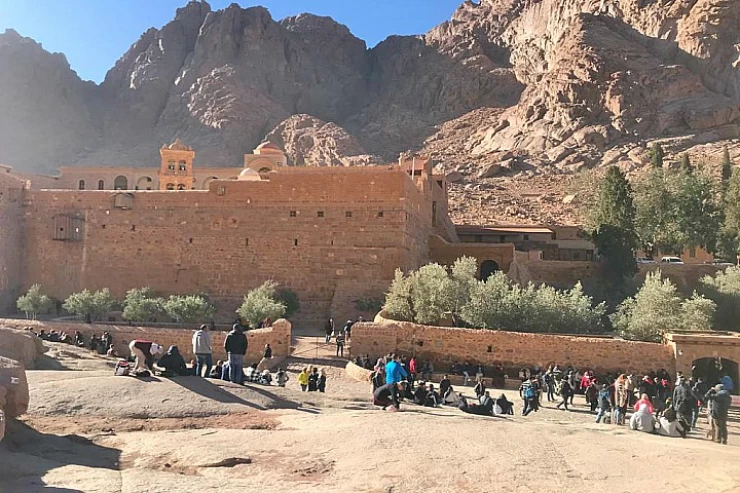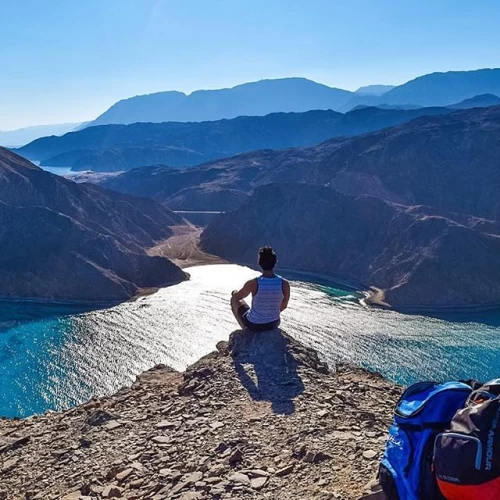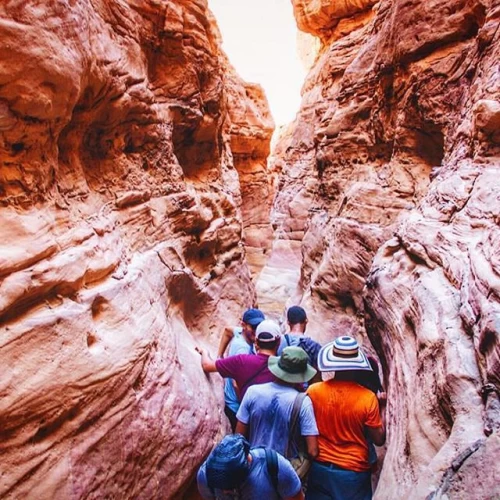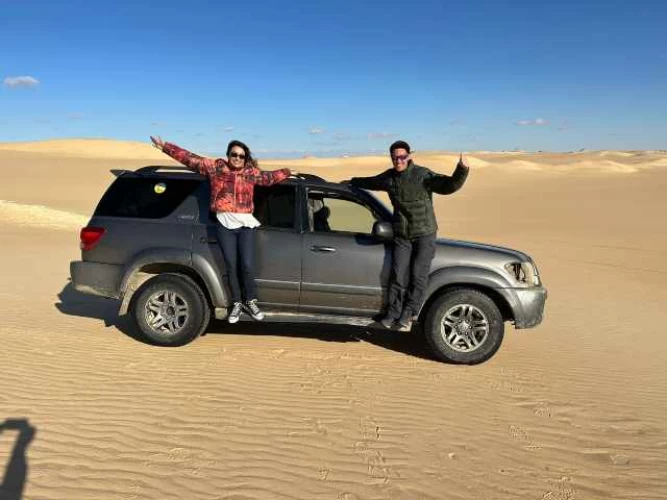
Mount Sinai (holy place)
Mount Sinai is the mountain on which God spoke to Moses and inspired him with the Ten Commandments in the Bible, the Old Testament, or the Hebrew Book. In Deuteronomy, some events take place on Mount Horeb, and some researchers believe that Mount Horeb is the same as Mount Sinai.
The position of Mount Sinai described in the Bible is still disputed, the peak of the dispute was in the middle of the XIX century. The texts of the Hebrew Bible describe the divine Transfiguration on Mount Sinai in terms that may literally describe the mountain as a volcano. Mount Sinai is one of the holiest places in Judaism, Christianity, and Islam.
The biblical account of the Giving of the instructions and teachings of the Ten Commandments was presented in the book of Exodus, mainly between chapters 19-24, during which Sinai was mentioned by name twice. The novel later adds that a fire was seen burning at the top of the mountain. In the biblical narrative, fire and clouds are a direct consequence of the arrival of God on the mountain. According to the biblical story, Moses left for the mountain and stayed there for 40 days and nights to receive the Ten Commandments.
The biblical description of God's lineage seems to contradict the statement shortly after God spoke to the Israelites from heaven. While biblical scholars argue that these passages are from different sources, makhilta argues that God brought down the sky and spread it over Sinai, perk de-Rabbi Eliezer that a hole was torn in the sky, that Sinai was torn off the ground and the top rushed through the hole. The word " heavens "can be a metaphor for clouds and" Lake of fire " can be a metaphor for a crater filled with lava. Many Bible critics have pointed out that the reference to smoke and fire from the Bible indicates that Mount Sinai was a volcano; although there was no ash. Other biblical scholars have suggested that the description fits the storm especially since Deborah's song seems to refer to rain falling at that time. According to the biblical account, God spoke directly to the people of Israel as a whole.
According to The Documentary Hypothesis, the name "Sinai" is used only in the Torah by the rabbinic and priestly source, while Horeb is used only by the Elohim and Deuteronomy.
The word Horeb is thought to mean" Glow / Heat", which seems to be a reference to the sun, while Sinai may be derived from the name of sin, the Sumerian moon god, thus Sinai and Horeb would be the mountains of the moon and the sun respectively.
Regarding the assumption of the Sumerian god of sin, William F. Albright, an American biblical scholar: there is nothing that requires us to explain him as a modified moon god. It is unlikely that the name "Sinai" was derived from the Sumerian name "Zin" (the oldest "zu-in"), Akkadian "sin", the moon god worshiped in ur (in his form Nanar), and in Harran since there is no indication that the name ` sin " was used by the Canaanites or Semitic nomads in Palestine. The name Sinai is most likely related to the place name "sin", which belongs to a desert plain in Sinai, as well as to a Canaanite city in Syria and possibly to a city in the region. Northeast of the delta of Egypt.
Similarly, in his book Sinai and Zion the American Hebrew Bible researcher John D. Levinson discusses the relationship between Sinai and the burning of the Bush (סנ ξ səneh) that Moses encountered at Mount Horeb in Exodus verses 3: 1-6. He emphasizes that the similarity between Sena (Sinai) and Sena (Bush) is not accidental; rather, the pun may derive "from the idea that the emblem of the God of Sinai was a tree of some kind". Deuteronomy 33: 16 defines Jehovah as "he who dwells in the Bush". Thus, Levinson argues that if the use of the word "Bush" is not a transcription error for "Sinai", the Deuteronomy may support the relationship between the etymologies of the word Sinai and the tree.
The oldest Christian traditions place this event near the serpal mountain, where a monastery was established in the IV of the last century. Century; it was only in the VI century that the monastery moved to the foot of Mount Catherine, by Josephus ' previous directives that Sinai was the highest mountain in the region.
Early references to Mount Moses as Mount Sinai or Mount Sinai located on the present-day Sinai Peninsula are inconclusive. There is evidence that before 100 BC, long before the period of Christian monasticism, the Jewish sages equated Mount Moses with Mount Sinai. Graham Davies of the University of Cambridge argues that early Jewish pilgrimages identified Mount Moses as Mount Sinai and this definition was later adopted by Christian pilgrims. R. K. Harrison states that " Mount Moses. It seems to have enjoyed a special sanctity long before the Christian era, culminating in its identification with Mt. Sinai".
The monastery of St. Catherine (Greek: Μονὴ τῆςγγίας Αἰκατερίνης) is located on the Sinai Peninsula, at the mouth of an inaccessible strait at the foot of the modern Mount Sinai in St. Catherine at an altitude of 1550 meters. According to the UNESCO report (60,100 ha/ref: 954) this monastery is called the "oldest working Christian monastery" in the world - although the monastery of St. Anthony, located on the Red Sea in the desert south of Cairo, also claims the title.
Christians settled on this mountain in the III century AD. Georgians from the Caucasus moved to the Sinai Peninsula in the 17th century, and a Georgian colony was formed there in the 19th century. Georgians erected their churches in the area of modern Mount Sinai. The construction of one of these churches was associated with the name of David IV, who contributed to the construction of churches in Georgia and also abroad. There were political, cultural, and religious motives for locating the church on Mount Sinai. The Georgian monks living there were closely connected with their motherland. The church had its plots in Kartli. Some Georgian manuscripts of Sinai are still there, but others are preserved in Tbilisi, St. Petersburg, Prague, New York City, Paris, or in private collections.
Mount Sinai is also mentioned in the Quran as "tur Sinai" and"tur Sinin". The peninsula is associated with Aaron and Moses, who are also considered prophets. In particular, numerous references to a mountain are found in the Quran, where it is called the Tur-Sina", and part of it is called "
The Blessed Spot."
Some modern biblical scholars explain that Mount Sinai was a sacred place dedicated to one of the Semitic gods, even before the Israelites encountered it. Others consider the given set of laws on the mountain to have arisen in different periods from each other, with subsequent laws being mainly the result of natural evolution over previous centuries, and not all of them originated from one moment in time.
Early references to Mount Moses as Mount Sinai or Mount Sinai located on the present-day Sinai Peninsula are inconclusive. There is evidence that before 100 BC, long before the period of Christian monasticism, the Jewish sages equated Mount Moses with Mount Sinai. Graham Davies of the University of Cambridge argues that early Jewish pilgrimages identified Mount Moses as Mount Sinai and this definition was later adopted by Christian pilgrims.
K. Harrison states that,
"Mount Moses. He seems to have enjoyed a special holiness long before Christian times, culminating in the recognition of Mount Moses".
In the II-III centuries BC, the Nabataeans performed pilgrimages there, which is evidenced by inscriptions discovered in the area. In the VI century, the monastery of St. Catherine was built at the base of this mountain on a site that is claimed to be the location of the burning bush in the Bible.
Josephus wrote that,
"Moses went up to the mountain that is located between Egypt and Arabia, which was called Sinai".
Josephus says that Sinai is,
"The highest mountains that are there", which are "the highest mountains that exist in that country, and it is not so difficult for men only to climb to them, because of its vast height but because of the steepness of its slopes". The traditional Mount Sinai, located on the Sinai Peninsula, is the name of a group of peaks, sometimes referred to as the peaks of the sacred mountains, which consist of Mount Moses, Mount Catherine, and Cape Willow. Etheria (about the IV century AD) wrote, "The whole group of mountains looks as if it were one peak, but when you enter the group, you see there are more than one".
The highest mountain peak is Mount Catherine, with a height of 8,550 ft (2,610 m) above sea level, and its sister peak Mount Moses (7,497 ft (2,285 m)), not further in height, but more visible due to the open plain. Mount Catherine and Mount Moses are both much higher than any mountain in the Sinai desert or in all of Midian. The highest peaks in the Teh desert in the north are no higher than 4,000 ft (1,200 m). Those in Midian east of Eilat rise to 4,200 feet (1,300 m). Even Mount Serbal, 20 miles (32 km) west of Sinai, at its highest is only 6,730 feet (2,050 m) above the sea.
Some scholars believe that Mount Sinai was of ancient sanctity before the ascension of Moses described in the Bible. Scientists theorize that Sinai partly derived its name from the word moon, which was " sin "(meaning" moon "or"radiance"). Antoninus the martyr provides some support for the ancient sanctity of Mount Moses by writing that Arab pagans were still celebrating Lunar feasts there in the sixth century. Lena Eckenstein recalls that some of the discovered artifacts indicate that"the establishment of the moon cult on the peninsula dates back to the pre-dynastic days of Egypt". She says that the main center of the moon cult seems to have been concentrated in the south of the Sinai Peninsula, which the Egyptians wrested from the Semitic people who built shrines and mining camps there. Robinson says that inscriptions with images of the cult of the Moon have been found all over the southern peninsula but are missing on Mount Moses and Mount Catherine. This strangeness may suggest religious cleansing.
Collections of laws were discovered in the south of Sinai, creating a kind of ring around Mount Moses. Noamites have been used repeatedly over the centuries for various purposes. Etheria, around the IV / V century AD, noticed that her guides, who were the local "holy men", pointed out these round or round stone foundations for temporary huts, claiming that the children of Israel used them during their stay there.
The southern Sinai Peninsula has archaeological finds, but placing them with mass migration from Egypt is a daunting task due to the widely different dates of the proposed exit.
Egyptian pottery in South Sinai during the late Bronze Age and early Iron Age the first (Ramesside) periods was discovered in the mining camps of Serabit el-Khadim and Timna. Objects with Proto-Sinaitic writings, such as those found in Canaan, were discovered in the Serabit Al-Khadim in southern Sinai. Many of them have been dated to The Late Bronze Age. These camps provide evidence of the presence of miners from Southern Canaan. The site of the remote server Mirage was used for a few months at a time, every two years at best, and more often once in a generation. The journey to the mines was long, difficult, and dangerous. The expeditions led by Professor Mazar examined Tel Feran, the main oasis in South Sinai, and discovered that the site is replete not only with Nabataean tombs but also with polished notches on wheels typical of the kingdom of Judea, belonging to the Iron Age.
Edward Robinson insisted that the plain of rest adjacent to Mount Moses could have accommodated the Israelites. Hal agreed with Robinson and stated that he had no other doubts after studying the large amphitheater leading to the base of the granite cliff at Ras Al-safsafa, where there was already a campsite and the mountain from which the law of God was delivered. A camp for Israelis is below.
F. W. Holland reported,
Some point to the lack of physical evidence left on the trip of the Israelis, but Dr. Beit Aryeh wrote, "It will probably be said, by those who uphold the traditional narrative in the Bible, that Israelite material culture was only of the weakest kind and left no trace. Presumably, the dwellings of the Israelites and artifacts consisted only of perishable materials."Hoffmeyer wrote," None of the camps on the Prairies could be meaningful if the Israelis went straight to Kadesh or Midian. A journey of eleven days from Kadesh to Horeb can only be properly understood about the southern part of the Sinai Peninsula".
The local Bedouins who have long inhabited the area identified Mount Moses as Mount Sinai. In the IV century AD small settlements of monks erected places of worship around Mount Moses. An Egyptian pilgrim named Ammonius, who in the past had made various visits to the region, considered Mount Moses to be the Holy Mountain in the 4th century. Empress Helena, California. 330 AD, a church was built to protect the monks from the raids of nomads. She chose the location of the church from the selection passed down through the generations through the Nomads. She also mentioned that the location was confirmed to her in a dream.
Christians traditionally considered the Sinai Peninsula to be the location of Sinai, although the peninsula acquired its name from this tradition, and it was not called in the time of Josephus or earlier. It was also called the turquoise country.
Bedouin tradition considers Mount Moses, located adjacent to Mount Catherine, to be the biblical mountain, it is this mountain that local tourist groups and religious groups nowadays advertise as the biblical Mount Sinai. This opinion was eventually adopted by Christian groups since a church was erected at the top of this mountain in the XVI century, which was replaced by a Greek Orthodox Church in 1954.
Mount Serbal, south of the Sinai Peninsula,
In early Christian times, several Assyrians settled on Mount Serbal, considering it a biblical mountain, and in the 4th century, a monastery was built at its base. However, Josephus stated that Mount Sinai was "the highest of the mountains that are there", implying that Mount Catherine was the mountain in question if Sinai was to be located on the Sinai Peninsula at all.


















